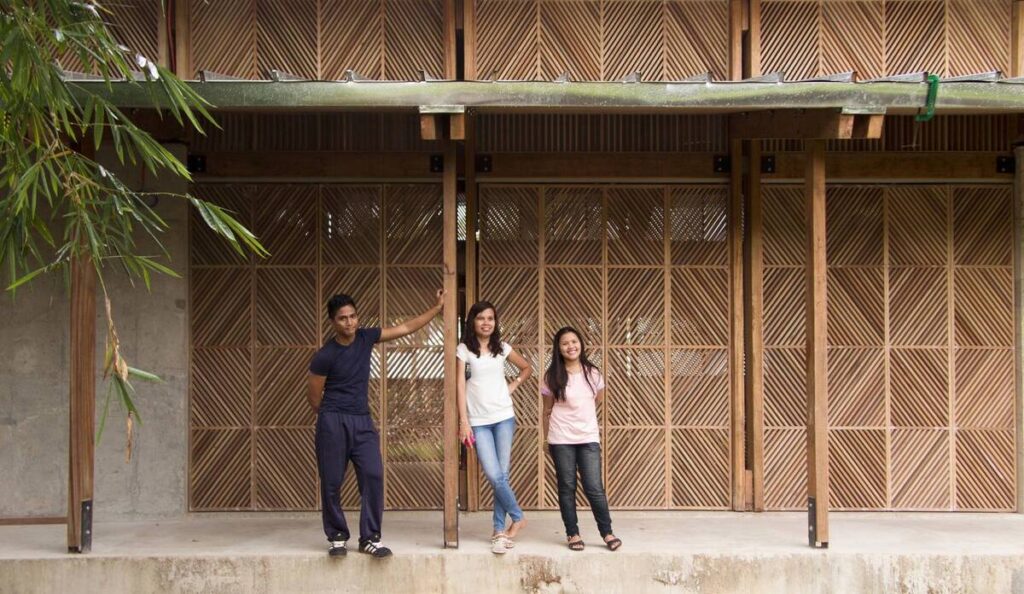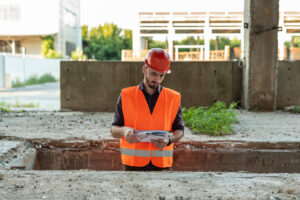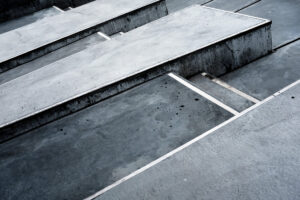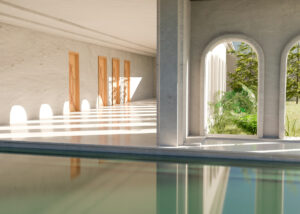Updated by Nazanin Ghodsian, 10/22/2024
Centuries of Spanish colonial authority, as well as American and Japanese occupation during World War II, have molded the Philippines’ rich and varied history. The architectural environment of the nation has been permanently impacted by these influences, creating a unique fusion of design and cultural elements that are still evident today. Construction projects in the Philippines , which range from imposing Baroque-style churches to primitive nipa huts, demonstrate the country’s strong ties to its rich architectural heritage and history.
Architecture from the nation’s colonial past is still visible, particularly in the enduring religious buildings. Examples of the Philippines’ Catholic legacy are the Manila Cathedral and the San Agustin Church in Intramuros, both of which are decorated with elaborate Baroque patterns. As reminders of the Filipino people’s tenacity and rich cultural heritage, these ancient churches have withstood natural disasters and conflicts. One of the nation’s oldest stone buildings, San Agustin Church is a UNESCO World Heritage monument that draws both tourists and history buffs.
The Philippines’ expanding economy and urbanization have been reflected in the country’s building developments in recent years. The real estate industry in the Philippines has had a 20% yearly surge in foreign direct investment, making it a popular destination for both foreign and domestic investors.
Construction projects in the Philippines act as a link between the nation’s ambitious future goals and its illustrious past. These initiatives, which range from the construction of state-of-the-art modern structures to the preservation of historic places, represent the Filipino people’s tenacity, inventiveness, and aspirations and will help to shape a future that embraces progress while paying tribute to their rich legacy.
Table of Contents
Top 7 Construction Projects in Philippines
Here is a list of the top 7 construction projects in Philippines worth learning about:
1. 100 Walls Church
- Architects: CAZA
- Area: 8924 m²
- Year: 2013

Despite a wealth of typological hints, we decide on an anti-form. It was not the legibility desired. The goal was to strengthen the search experience. Religions are characterized by the mysteries they contain and the accounts of those who manage to solve them.
We are never quite at home, and this shared sense of exile is what increasingly characterizes their current situation.
A glimpse of something unfamiliar that defies symbolism and evokes a subdued sense of expectation could be an example of the sacred in architecture. This construction project in Philippines’s design is an attempt to consider oddities in architecture. Imagine being able to observe something we don’t understand. Like Christ in the grove of Gethsemane, we are perplexed and in need of saving.
This construction project in Philippines is entirely opaque from one perspective and completely transparent from the other because all of the walls are only oriented in one way. There is an optical dance of light and dark somewhere in between these two states. The walls are arranged in a grid that corresponds to the distance between the pews, signifying the connection between the two scales—the cosmic scale of the universe and the minute scale of the person. The clerestory windows allow colored light to filter in, which contrasts with the walls’ monolithic appearance. After all, the sacred is intrinsically connected to the reality that, although our building strives for permanence, we are only here for a brief period.
Possibly one of the most poignant assertions of this puzzle was the gothic concept of space. The greatest cathedrals in medieval Europe aimed to convey to their congregants the idea of God as a mysterious and enlightening being through an architectural image of a dense and layered mass of buttresses, ribs, vaults, and spires. Explore the grounds of this construction project in Philippines and you will find pockets of blue light, subterranean gardens, and an intriguing abundance of talismanic walls. A sacred place today should find meaning in its enigma; the abundance of doors and pathways serves as a reminder that there are as many paths as there are lives.
2. Streetlight Tagpuro
- Architects: Eriksson Furunes, Leandro V. Locsin Partners
- Area: 1200 m²
- Year: 2016

One of the fiercest typhoons to ever make landfall, supertyphoon Haiyan, struck the Philippines on November 8, 2013, demolishing over four million homes and taking thousands of lives. The typhoon’s waves destroyed the Seawall informal settlement and the Study Center, which they constructed in 2010 in collaboration with the NGO Streetlight and three architecture students. After providing help to the families and children during the crisis, Streetlight quickly restarted its educational and vocational program. Together with his two partners, Sudarshan Khadka and Jago Boase, Alexander Eriksson Furunes was invited back to restore Streetlight’s office, orphanage, and study center in the Tagpuro displacement zone.
It was once a little town with 200 households, but the city government’s relocation plans called for a tenfold rise in population. Opportunities for a living and infrastructure that provides needs like power, water, and sanitary facilities were not taken into consideration in this growth. As a result of some families’ lack of sense of belonging to their new home and neighborhood, tension and disputes were rising in the area. The challenge then arose as to how we could collaborate and leverage the design and programming processes to create something suitable for the relocation zone’s existing circumstances.
To envision the design of the new structures, ascertain their purposes and schedule, and discover locally accessible materials and construction methods, several community workshops were arranged. The community created a shared vocabulary to discuss and debate ideas and solutions that were important to them collectively through sketches, models, and full-scale mockups. They came up with the ideas of “Open & light” and “Closed & safe” after witnessing the typhoon’s destructive winds and seas. Therefore, ventilated light timber structures were created for natural ventilation that also allowed powerful winds to travel through the buildings, while hefty concrete volumes were employed to give shelter during typhoons.
The orphanage is made up of three of these concrete volumes, with bedrooms on the second floor and kitchen and bathrooms on the ground floor. In between the big volumes are areas for daytime recreation that are ventilated. The study center is divided into massive volumes that include music rooms, a library, restrooms, kitchens, and instructors’ rooms; the spaces between the volumes contain classrooms with facilities for theater, dancing, and singing. The three large volumes that make up Streetlight’s office, which doubles as a vocational training facility, have shared workspaces in the open spaces plus conference rooms, restrooms, and a janitor’s office.
3. Viewpoint House
- Architects: Jim Cameron Design
- Area: 400 m²
- Year: 2020

This construction project in Philippines features a cozy internal core that is protected by a white concrete “hood” with trapezoidal recesses framing the views of the exterior. It was created by Jim Caumeron Design and is known as Viewpoint House. situated in Quezon City, Philippines, in a crowded subdivision.
To accommodate the substantial 400 square meter client’s space requirements, the L-shaped lot required an L-shaped plan. There are no views to the east or back of the land due to a neighbor’s fence wall blocking the vista. Conversely, the lot is exposed to the afternoon sun’s heat on the west side. In addition, this side faces a small community park and the street, which could be a privacy concern if the living rooms faced west.
Jim Caumeron suggested adding a large picture window on the corner of the house to draw attention to the park view. Raised above the average human height, this window functions as the “Mother” window, reducing the amount of the living room that is visible from the street. The large window in the living space provides a view of the tree’s crown when one is relaxing.
The west side of this construction project in Philippines housed the entrance hallway, stairs, and ribbon window that overlooked the park and street. Above it is a wall of tiny perforations with a tilted profile section feature that lets natural air pass through but keeps rains out. While providing shade from the midday sun, this wall also lets natural airflow into the stair atrium.
The bottom floor guest room and dining room maintained their small, private open spaces in the setback. A square, frosted glass door from the living room draws attention to the garage, which may be converted from the living space into an expanded party space. Filipinos typically invite everyone in the community to a feast during fiestas, christenings, house blessings, etc. Usually, the best place to keep the main living and eating areas private and somewhat exclusive to family and close friends is the garage area, where a large table can be put up.
4. Twelve Luxry Flats
- Architects: WTA Architecture and Design Studio
- Area: 6,400 m²
- Year: 2020
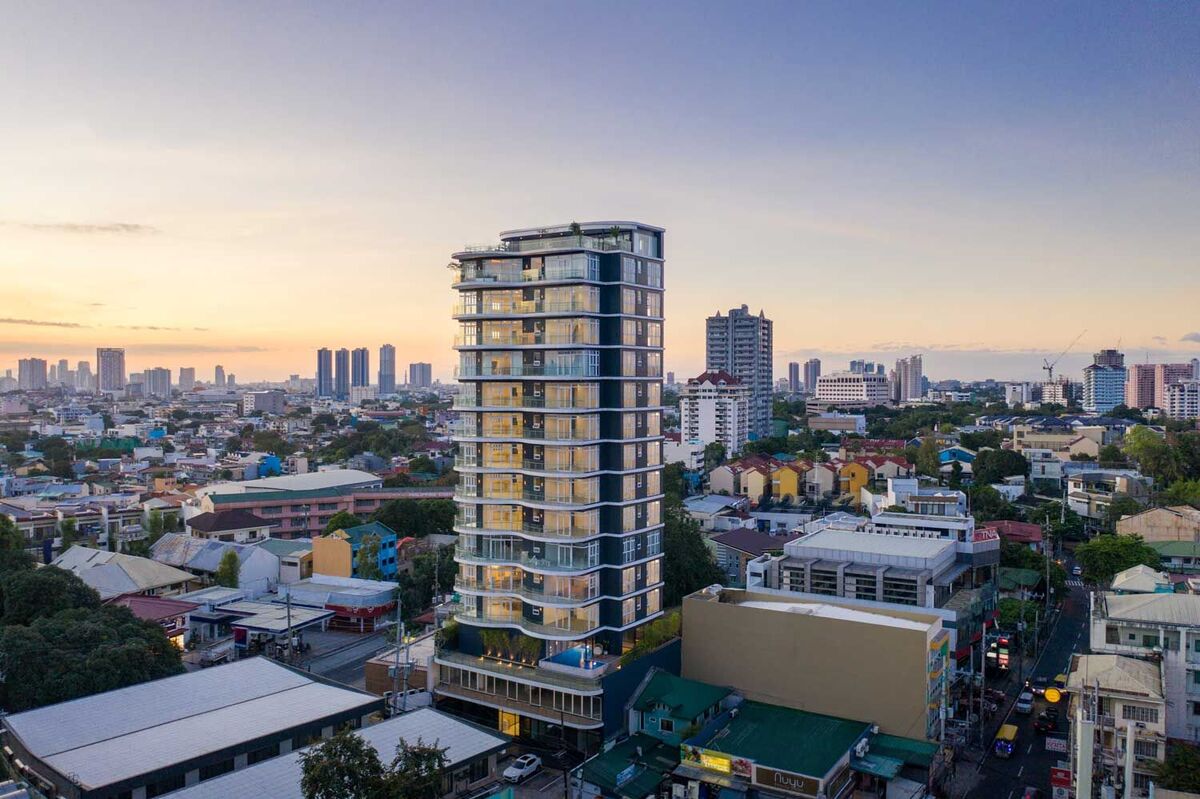
This sixteen-story residential construction project in Philippines rises on a 586-square-meter lot in a premium area in San Juan City, Metro Manila, Philippines, combining the practicalities of vertical living with the comforts of an urban townhouse. The twelve opulent residential apartments, each measuring a spacious 258 square meters, are situated on a distinct floor of their own. The total gross floor area of this building is 6,400 square meters, which includes two stories of commercial space and an additional story for amenities.
Each of the twelve luxury apartments is designed with roomy interiors, daylighting, and ventilation on all four sides. It provides the luxury of living in a large area with unobstructed views, at one story per apartment. The layout of the apartments is designed to accommodate both social events and private times. The main living and dining area of the design is surrounded by floor-to-ceiling windows that lead to an opulent veranda. This intimate, yet wide-open area fosters a connection with the sky and makes it possible to blur the lines between inside and outdoor space.
5. City Center Tower
- Architects: CAZA
- Area: 1,000,000 sqft
- Year: 2016
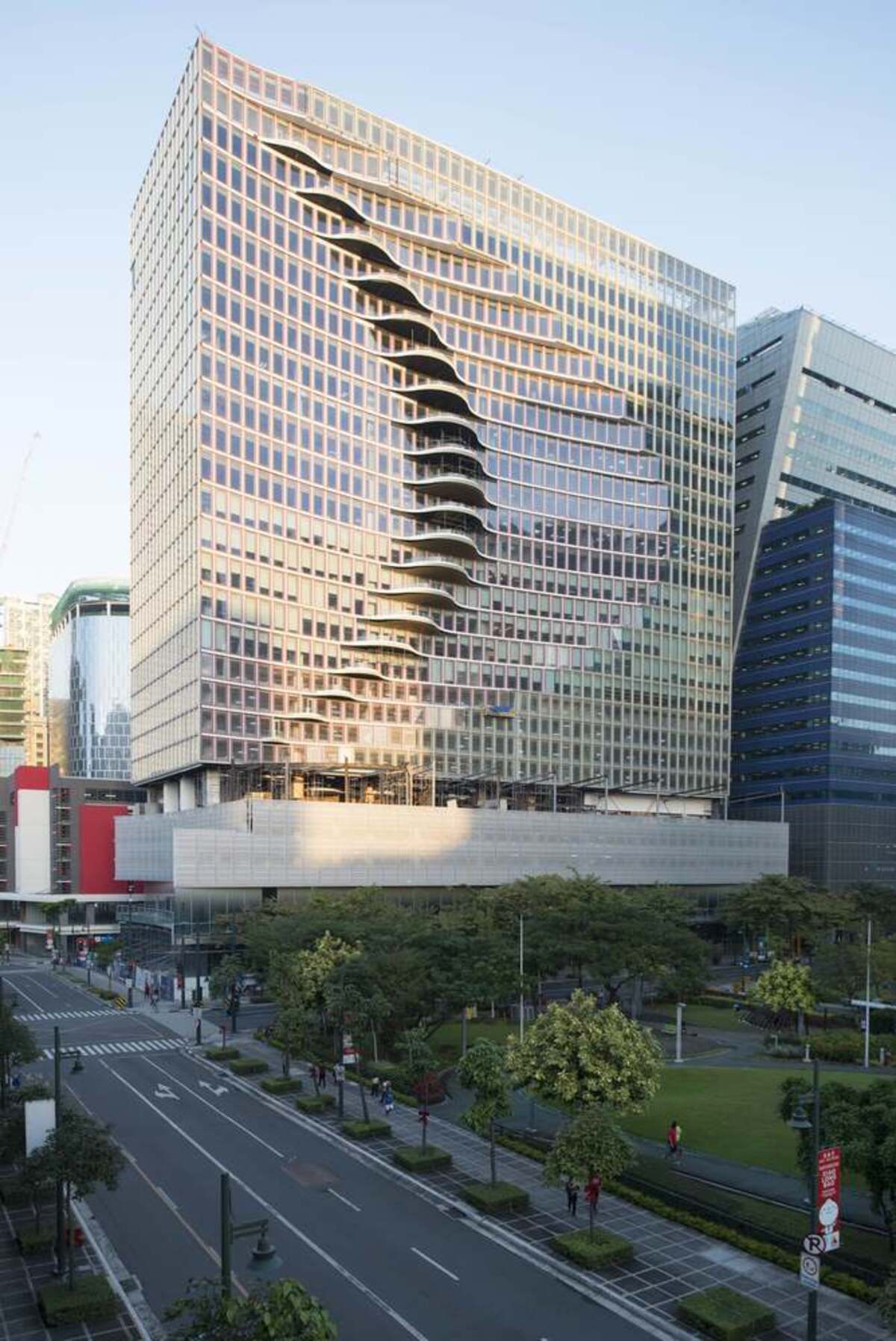
CAZA (Carlos Arnaiz Architects), is a Brooklyn-based architecture and design firm, with offices in Bogotá, Colombia; Lima, Peru; and Manila, Philippines. The 27-story-tall mixed-use structure, whose construction is expected to be finished this month, will house the corporate offices of multiple well-known worldwide corporations in addition to three floors of commercial retail and dining space.
The goal of this construction project in Philippines was to challenge the typical core and shell layout of typical corporate office buildings by incorporating surprising and pleasantly novel shapes that provide consumers with novel experiences. A sequence of concentric circles that span the horizontal axes of every story is incorporated into the outer façade of the skyscraper, combining the free-form organic pattern of a wave with the structured geometry of a cube. The visual effect that results inspires inventiveness and efficiency while keeping a hint of lightheartedness.
“The arrival of the BPO industry has caused an unimaginable explosion in office development in the Philippines over the last fifteen years,” says Carlos Arnaiz, principal and founder of CAZA Architects. We are looking for a manifestation of this new sociocultural paradigm as architects. One of the earliest construction projects in Philippines that reflects the evolving nature of the workplace—where offices and the natural world coexist throughout the 24-hour day—may be the City Center Tower. This will enhance the realism of how the BPO office environment functions.
The tower’s bright, open double-height lobby greets guests and encircles two floors of commercial retail space, making the tower a vibrant hub that is both open to the public and alive with activity. Above these shopping areas are large raised parking lots that line up with an operational cooling tower that can handle a passive cooling system that can adjust to the tropical heat of the Philippine capital. The building’s nearby park is visible from the lofted rooftop restaurant situated on the fifth story, above the retail zone and parking facilities. From its large balcony area, the restaurant offers a view of the park and features an urban beach with a wading pool, hammocks, and lounging spaces.
6. Spark Place
- Architects: ASYA Design
- Area: 42,000 m²
- Year: 2016
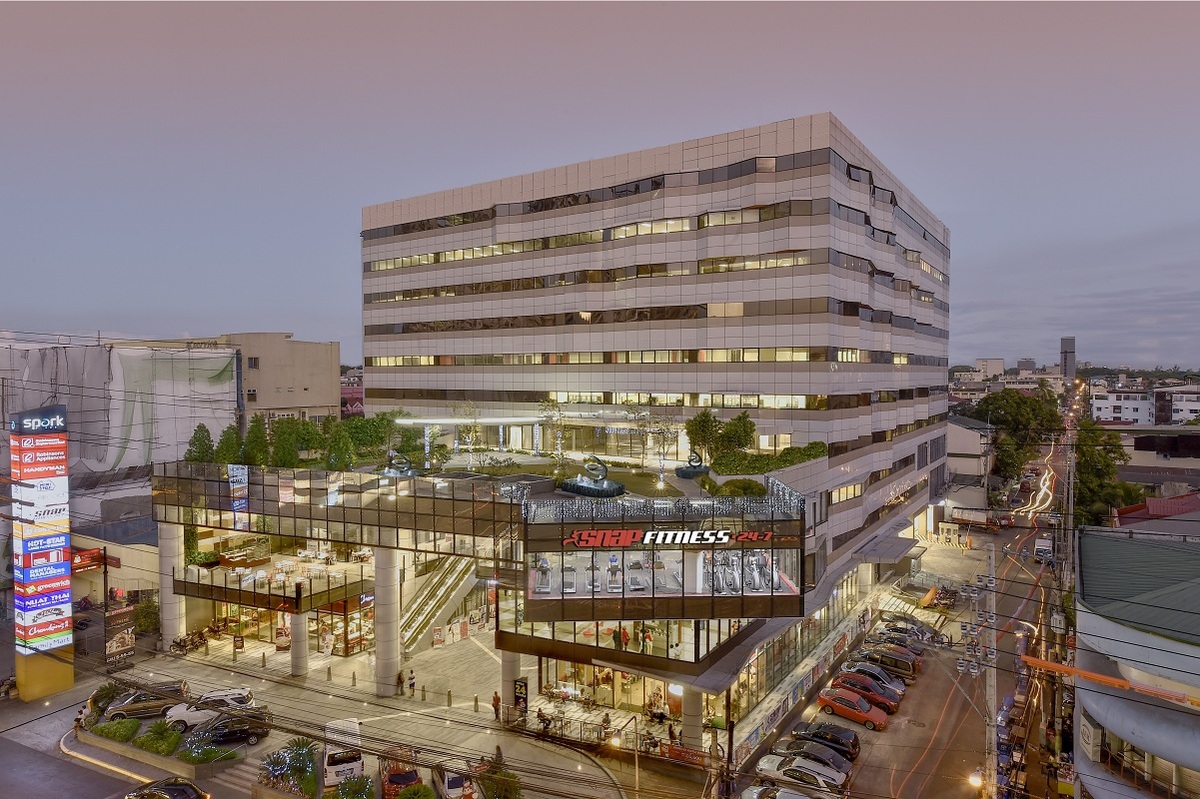
The first design-built project completed by ASYA Design is evidence of the company’s commitment to excellence in the design process, from project conception to fit-out detailing. This construction project in Philippines is a 42,000-square-meter mixed-use development that rises to satisfy the growing demand for business centers while presenting the state of the art architecture amidst a sea of antiquated boxy structures. It is the ideal marriage of design and function, making the most of office space while combining well-chosen commercial areas.
The development is situated in Cubao, a municipality that has been the center of Metro Manila’s busiest districts since the 1960s. Major mass transit lines and other integrated public transportation transits are well connected to the location. Thus, the requirement for basement-level bicycle storage areas.
These days, Cubao has long since passed its prime and is becoming a congested and dirty transportation hub. However, Spark Place turns out to be the exact reverse of what people think. The mixed-use development, which stands in stark contrast to the heavily urbanized surrounding area, seeks to revitalize the ancient city and restore its former status as the hub of trade and commerce. This construction project in Philippines is an example of genius since it incorporates a lot of green elements and facilities into its sleek, modern form. This helps to promote responsible and sustainable development.
This construction project in Philippines optimizes the use of available space by accommodating more people per level, thanks to its 3,100 square meter floor plate and 4.5 square meter density per person. Because most employees may work from one floor, the program is efficient because it needs less management to keep an eye on the region. The 500 square meter foyer has a 7-meter high ceiling that adds extra space for both visitors and staff. The building’s four-story platform, which hugs the site’s contours, optimizes the building’s use for development. The box-shaped office tower emphasizes efficiency with all elevators centered in its core, even with its angular, undulating façade cladding.
7. Bahay Sibi House
- Architects: Platform 21 Architecture
- Area: 300 m²
- Year: 2019
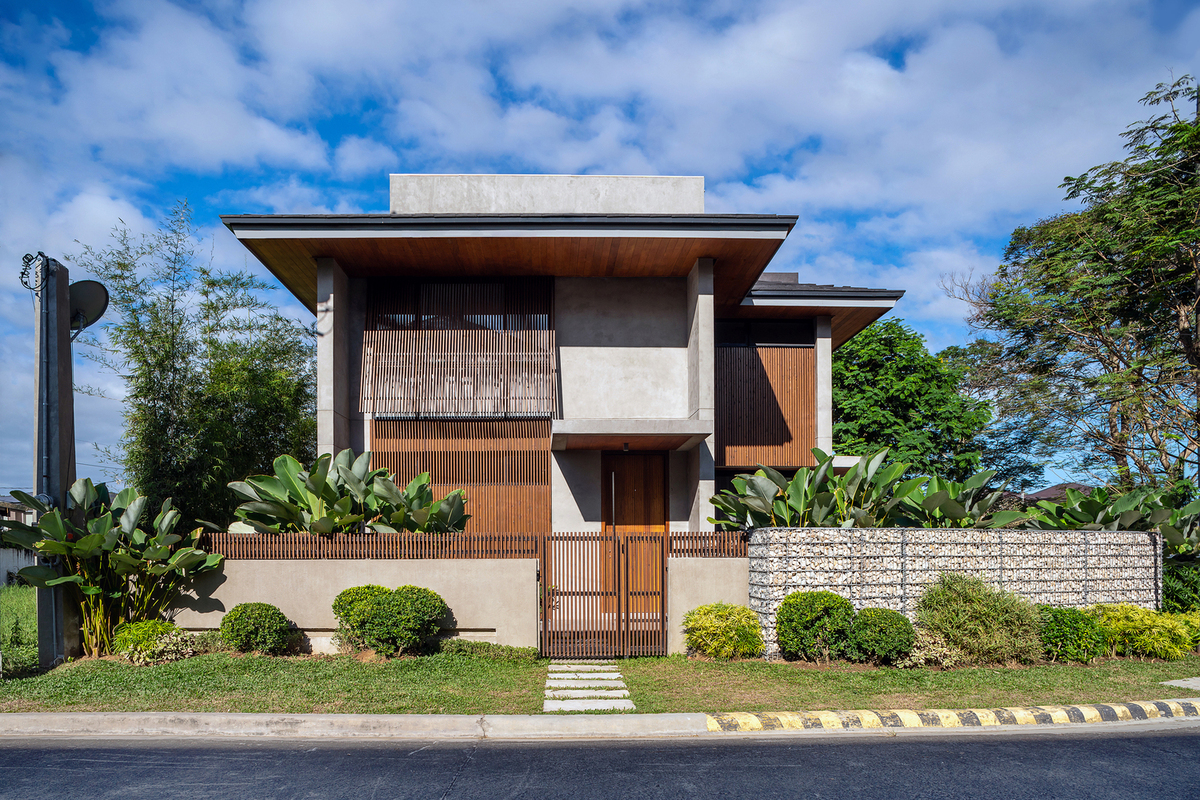
This construction project in Philippines is a three-story concrete and wood home in Baliuag, Bulacan, tucked away on a 300-square-meter corner lot. Bolder concrete volumes provide a striking visual play, counterbalanced by the wood eaves, external paneling, and distinctive sun screening. Its two fronts exhibit an intriguing interplay of façade, evolving from separate volumes rendered unified by a recurrent brise soleil evocative of the sibi, the house’s namesake.
Platform 21 Architecture aims to construct a home that embodies the Filipino ideal in Bahay Sibi. A prominent feature of the bahay kubo, a well-known Filipino vernacular house, is the Sibi, an extension of the roof over a window. The Sibi serves as the main barrier against weather, withstanding both bright sunlight and severe downpours. It is a crucial element of tropical architecture.
Based on this idea, Platform 21 Architecture breathed its modern interpretation into the Sibi, transforming it into a home fit for the modern era. The property faces mostly north and east, thus plenty of light from the morning sun was taken into account. The garden and lanai were located along the northeastern side of the land, while the living and dining areas were located along the east and north sides, respectively.
The purpose of fenestration was to allow for plenty of wind and sunlight. The early versions of the sibi are visible along the fenestration of the main public spaces, blocking heat and offering light to alleviate extreme heat during the day. The brise-soleil with sibi patterning spreads upward to the second story, where it still provides shade for the bedrooms facing East and North roads. With their straightforward and practical design, the bedrooms are ideally situated to take advantage of views while also allowing for some seclusion.
Conclusion
The intricate cultural identity of the Philippines is reflected in its architecture. It’s an intriguing fusion of contemporary styles, colonial influences, and indigenous design. We have witnessed everything from the pre-colonial nipa huts to the opulent stone homes of the Spanish era, which eventually gave rise to contemporary glass and steel buildings. But let’s not get carried away. Let’s go back in time and begin at the beginning.
Another major factor influencing construction project in Philippines’s future is technology. Before building begins, architects may more easily envisage and modify their plans thanks to digital tools like virtual reality and 3D modeling. This enables more inventive and imaginative designs while also saving time and money. The architectural legacy of the Philippines is becoming increasingly appreciated. To create structures that are both forward-thinking and grounded in history, architects are figuring out how to combine traditional Filipino components with contemporary architectural concepts.
In conclusion, the Philippines’ modern architecture of the future promises to be an intriguing fusion of creativity, sustainability, and sensitivity to cultural legacy. The Philippines has a long history of producing distinctive and inspirational architecture, and this trend looks set to continue.
FAQs
What are the Most Notable Architectural Features of the 100 Walls Church?
- Answer: The anti-form architecture of the 100 Walls Church highlights the dual qualities of transparency and opacity. In order to represent a link between the cosmic and human scales, the walls are structured in a grid that matches the spacing between pews. In contrast to the monolithic walls, the clerestory windows let in colorful light, which heightens the meditative ambiance.
How did the Streetlight Tagpuro Project Respond to the Aftermath of Typhoon Haiyan?
- Answer: After Typhoon Haiyan ravaged the area, the Streetlight Tagpuro initiative was a cooperative attempt to reconstruct. In order to determine needs and create designs for new buildings that would support education and offer shelter, the architects held community workshops. The resultant structures are made with safety and ventilation in mind, using concrete for stability in storms and lightweight timber for flexibility.
What Design Considerations were Taken for the Viewpoint House in Quezon City?
- Answer: For the best views, Viewpoint House has a protective white concrete “hood” with trapezoidal niches. The L-shaped design maximizes natural light and circulation while addressing privacy issues. The living area is made more comfortable by a distinctive wall design that lets in air while keeping out rain and a wide picture window that connects to the nearby park.
What Amenities can Residents Expect in the Twelve Luxury Flats?
- Answer: The interiors of the Twelve Luxury Flats are roomy and have air and daylighting on all sides. Each apartment has a primary living space with floor to ceiling windows opening to large verandas, making it ideal for both social events and privacy. Two floors of amenities and commercial space are also included in the structure, offering a complete living environment.
What Makes the City Center Tower a Unique Addition to the Manila Skyline?
- Answer: The creative design of the City Center Tower, which combines geometric and organic features, makes it stand out. Concentric circles on its façade defy conventional corporate office designs, resulting in a lively, open lobby and mixed-use areas. By including green areas and encouraging an active urban environment, the proposal reflects the changing character of the workplace.
How does the Bahay Sibi House Incorporate Traditional Filipino Architectural Elements?
- Answer: The bahay kubo, especially the sibi, which extends the roof to give shade, is the model for the Bahay Sibi House. Brise soleil is used in this contemporary version to improve ventilation and regulate sunlight while maintaining the character of tropical architecture. The arrangement follows Filipino customs while maximizing natural light and ventilation to create a cozy living space.
Suggested article for reading:
LCA and Carbon Footprint: 10 Effective Reduction Strategies
The Role of PIM in Sustainable Construction (2024)
Top 23 Famous Women Architects in World; 2024 Review
Case Study: Top 4 Eco-Friendly Smart Building Construction Projects
IIoT Technology: Top 7 Sustainable Practices It Enables
10 Top IoT Companies in Denmark (2024)
Top 7 Construction Project in Netherlands
Top 23 Famous Women Architects in World; 2024 Review
7 Top Construction Projects in Sweden
11 Top Construction Project in Malaysia
Top 7 Construction Project in Turkey
11 Top Construction Project in Saudi Arabia
Resources:
Daisie | Architizer | Archdaily | Archello | Ianfulgar | GlobalData | Binus | Hoppler
For all the pictures: Archdaily

